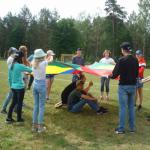What develops the rope. Circuit training: rope exercises for real superheroes. Circuit training with loops for men
Training rope for crossfit finds wide application V functional training amateur and professional athletes various types. It looks like an extremely simple projectile, but it has great benefits and range. possible exercises. All movements are based on transferring the impulse created by the hands to the rope in a wave-like motion. Based on this, we can make certain requirements for the projectile:
- Flexibility— the crossfit rope must be flexible enough for smooth transfer of force.
- Length- this parameter will affect the maximum force that can be applied to the projectile.
- Specific gravity per 1 m— together with the length will set the level maximum effort and possible modes of working with the rope. For example, a light and short rope will not be relevant when working on explosive power.
- Wear resistance— the projectile is in constant contact with the floor and when working with hard surfaces, it is important that the rope withstands friction and lasts a long time.
- Softness of material— an important parameter when working on wrestling mats, tatami and other soft floor coverings subject to abrasion. Some types of synthetic ropes are tough and can damage your flooring if used for long periods of time.
All these parameters are directly determined by the selected material.
Choosing rope material for CrossFit
For clarity, we will display the characteristics of the materials in a table where we will show the strengths and weak sides ropes for functional training. The selection is based on the Ultimate Sport range of ropes nominal diameter 40 and 48 mm.

|
Name |
Cotton Ultimate 40 mm |
Original Ultimate 50mm |
|||
|
Specific gravity per 1 m |
|||||
|
Flexibility |
|||||
|
Wear resistance |
Minimum |
Minimum |
|||
|
Fiber stiffness |
|||||
In simple words:
Cotton (CB) rope entry level, due to natural fiber it is easily damaged and cannot be repaired, flexibility indicators are average. The main advantage is the price.
Jute sports rope has the same problems as CB ropes. Natural jute fiber frays a little during use. Therefore, we mostly recommend using it outdoors.
Black synthetic rope - Wear-resistant, three-strand models have problems with unraveling, we recommend considering the Prime model with a special type of weaving. Easily repaired with a lighter. Good rope flexibility.
Advantages and disadvantages of materials:
|
Advantages |
Flaws |
|
|
Cotton Ultimate 40 mm |
Low wear resistance, frays |
|
|
Original Ultimate 50 mm |
Soft touch, environmentally friendly material |
|
|
Synthetic Ultimate Prime 50mm |
It has no analogues on the Russian market. High wear resistance, average characteristics, price/quality ratio. The rope consists of three fibers, each fiber has a special weave that prevents unraveling, even with very frequent use |
Thanks to the special weaving, the rope is highly flexible |
|
Synthetic Ultimate Elite 40mm |
Soft, flexible, will not damage the floor covering (wrestling mat, mats, tatami), looks premium in appearance. It has good performance on shock wave absorption. |
Not suitable for outdoor activities and hard surfaces (sand, asphalt) |
|
Synthetic Ultimate Strong 40 mm |
Heavy, suitable for really physically developed and strong athletes who no longer have enough standard rope. Great for practicing explosive movements |
Hard fiber, combined with weight, can damage the floor covering (parquet, mats, tatami, carpets) |
Choosing rope length for crossfit and functional training
The main recommendation is the longer the better. A long rope will allow you to use the entire range of possible exercises for athletes of various levels of fitness. There are no exact characteristics when choosing the length. Everything is determined by the athlete’s level of preparedness, the specific gravity of the projectile per 1 m, and the surrounding space in which the rope is used.
- 9 m - beginners, children, girls.
- 12 m - average athletes, teenagers, girls with a certain level physical fitness
- 15 m - most men of average fitness level, strong women, university level
- 20 m - trained athlete (wrestling, rugby, skiing, hockey, etc.)
- The 25m is a real beast when it uses the full potential of the rope, for the most powerful athletes.

In general, these are all the characteristics that will help you choose a rope. If you have any questions, you can always get professional advice from our specialists. We are always open for communication, we will help you produce a rope according to your requirements and needs.
Good luck to you in achieving your goals! Have a good mood!
At first glance, exercises with ropes may seem stupid to many. In fact, such training is no less, and in some ways even more effective. strength exercises. Strength training is important for a fighter, but it needs to be diluted with something. Ropes are not bad for this.
Exercises with ropes develop both strength and endurance in a fighter. By performing exercises for at least 30 seconds at a fast pace, you will load your muscles no less than in the gym.
Why should you include rope exercises in your workout?
The two main benefits are the development of endurance and the strengthening of many muscles. It strengthens the forearms very well and strengthens the grip; it also strengthens the muscles of the back and shoulders. You can focus on almost any muscle. Moreover, due to the absence of large weights, such exercises are safe for joints. Also, such workouts do a very good job of burning excess weight.
Execution technique
The essence of the exercise is to create wave-like movements in the rope. They can be performed with different amplitudes and in different planes. In this case, you can use different lengths and thicknesses of the rope, and also use a wide variety of grips. If you want to increase the load on your legs, squat lower.
Make sure that the movements are performed with the whole body. Only correctly performing exercises with ropes will allow you to include all links of the biomechanical chain from legs to arms. And the ability to engage all the muscles during a strike or technique is very important for a fighter.
There is no point in explaining the technique; it is better to see once than to hear a hundred times.
Thank you, very interesting article
[Reply] [Cancel reply]
You may be surprised to learn that rope training can be used not only to climb, but also to increase endurance, arm strength, grip strength and many other characteristics. I'm talking in this case about a rope wave.
What is a rope wave?
The first person to use the “art” of the rope wave in his training was John Brookfield. He used a variety of swinging and circular movements to raise the heart rate of athletes and increase the body's endurance.
Rope wave is used as the main tool in high intensity training(HIIT) to develop the athlete's strength, explosive power, as well as anaerobic and aerobic capacity body.
The rope for all these types of exercises is a little different from what we are used to climbing. As a rule, it has a length of 7 to 15 meters and a thickness of 2.5 to 5 centimeters. The weight of the rope can vary significantly depending on its length and thickness. Typically, the end of the rope is wrapped with thick tape to make it comfortable to hold.
Benefits of training
- Low joint tension
- Balancing body imbalances
Versatility
You can literally train anywhere there is enough of it and a strong support to secure the rope
Functionality
Rope work involves the entire body, training the neuromuscular system by using core strength and transferring it to the arms. In addition, the high intensity and fast nature of cable training will effectively develop cardiovascular endurance, not to mention the fact that such a workout is excellent for burning excess fat.
Mood
The mindset to overcome obstacles and difficulties. When you start using rope training, you start to push yourself. In the future, Fran will not seem so difficult to you.
It's fun
If you are tired of working with a barbell, then ropes are just for you. A huge number of exercises that will add variety to your workouts.
To learn basic rope exercises, watch this video.
Next time you come to training, be sure to try doing exercises with a rope, because they will not only add variety to your training process, but will also make you much stronger and more resilient.
instructor at the fitness boutique “Granatny, 4”I enjoy incorporating rope into my circuit training. For one approach I give 4-5 different exercises: burpees, push-ups, kettlebell swings, box jumps and finally the rope. You need to perform each exercise for 10-20 seconds, rest between each exercise for 5 seconds. And so 2-3 circles (rest between circles - one and a half minutes). How often can it be done? I think you should consult a personal trainer - it all depends solely on your condition.
I like this workout, because you get tired instantly, and your endurance increases just as quickly, the muscles of your back, shoulders, arms and even legs (if done with jumping) are well worked out. These exercises were extremely popular during the Soviet era; the national wrestling team - and as we know, it was the strongest - always included exercises with a rope in their training.
For this workout, you definitely need to be prepared. You should not have any contraindications or cardiovascular diseases, since this is a work of wear and tear.
Now let’s repeat once again what your most powerful circuit training should look like, which will increase endurance and burn a ton of calories (just imagine, 750 calories is two servings of pasta, 2.5 slices of cake, 2.5 cheeseburgers or 3 chocolate bars with nuts and caramel).
- 10 minutes .
- 1 minute, 5 seconds rest.
- 1 minute, 5 seconds rest.
- 1 minute, 5 seconds rest.
- 1 minute jumping onto the box, 5 seconds rest.
- 1 minute rope, 5 seconds rest.
- 1.5 minutes rest.
- repeat 2-3 times.
We have already told you how to do all the above exercises. Now we are sharing exactly what exercises you need to do with a sports rope. Remember that in one circle in the rope station you can include about 4 different exercises with this device. Go!
How to do it correctly:
- Get into the plank position on one arm (the hand should rest not on the floor, but on a special stand);
- The second hand should hold the rope;
- Slowly begin to make a wave movement from side to side, gradually accelerating.
Work until the heart rate monitor reaches a critical point.
Side plank with rope
This is a very simple exercise for those who have mastered the side plank.
- Get into a side plank position with the main weight resting on your elbow;
- Maintain deflection;
- In the other hand, take the rope by the tip;
- And slowly - by turning your body back and moving your shoulder blades, move the rope towards you.
It is important to do this not with your arms (biceps muscles), but with your back and body.
- When you reach the end of the rope, turn to the other hand and continue the exercise.
The main feature is cyclicality and high involvement rhomboid muscles back, and oblique abdominal muscles. The movement occurs solely due to traction with the elbow (not the wrist), which allows you to completely disable the shoulders.
Bottom line
As can be seen from all of the above, exercises with a rope can replace almost all equipment gym. After all, during work, both the muscles of the legs and abs, as well as the muscles of the back and upper shoulder girdle. The ability to constantly increase the load without risking injury makes the exercises most effective for all groups of athletes, both beginners and advanced experienced athletes.
And most importantly, eliminating inertia in most exercises allows you to work not only on strength and endurance, but also on explosive characteristics. It is due to the explosive elements that the muscles are worked as deeply as possible (after all, about 80% of muscle fibers), and with the correct load, exceptionally dry muscle mass, with high recovery capacity. Therefore, rope exercises are highly recommended for those athletes who engage in impact sports. Working with a rope allows you to increase the impact force up to 7 times in 2 months of training.




